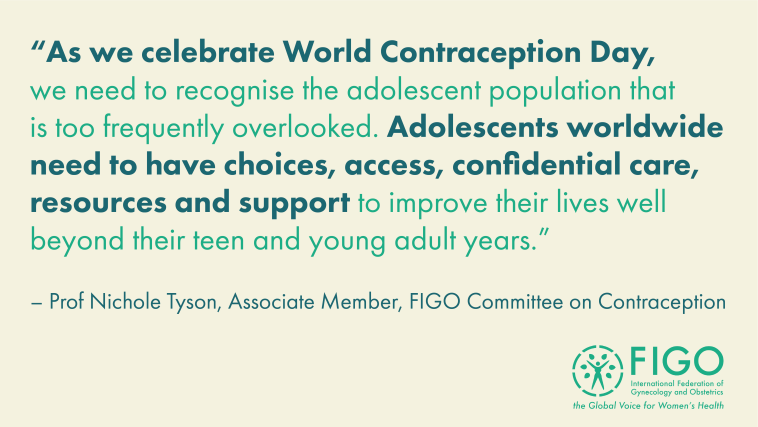World Contraception Day: let’s focus on the adolescent

On this World Contraception Day 2022, Nichole Tyson, Clinical Professor of Obstetrics and Gynecology at Stanford University School of Medicine and specalist in paediatric and adolescent gynaecology, shares with FIGO the importance of focusing on the adolescent population when discussing global contraceptive needs.
Who is an adolescent?
Adolescence is the phase of life stretching between childhood and adulthood, and its definition has long posed a conundrum. Adolescence includes elements of biological growth and major social role transitions, both of which continue to evolve. Earlier puberty has accelerated the onset of adolescence in nearly all populations, while appreciating continued growth of the teen has extended definitions of adolescence into the twenties. Completion of education, qualification for parental health insurance (for some, insurance coverage is effective through age 25 in the United States), and parenthood all contribute to the ambiguity. Previously, adolescence had been considered to encompass age 10–19 years, however a more modern definition of 10–24 years corresponds more closely to adolescent growth and popular understandings of this life phase.
Adolescent contraception is unique
An adolescent birth control prescription is an intervention for far more than prevention of an unplanned pregnancy. Globally, 65–95% of adolescents experience period pain, and, of these, up to a quarter of menstruating people miss school and activities during their menses. Birth control serves as a gold standard treatment for dysmenorrhea. Likewise, birth control is the mainstay treatment for heavy menstrual bleeding, acne, hirsutism, ovarian cysts, breast pain, polycystic ovarian syndrome, and catamenial concerns such as menstrual-related headaches, seizures, asthma, premenstrual syndrome and premenstrual dysphoric disorder.
Infrequently discussed in adolescents are the tremendous cancer-protecting benefits of hormonal contraception. The use of combined hormonal contraception reduces the risk of ovarian cancer, uterine cancer and colon cancer. Teens with health concerns have their sexual debut as early and as often as teens without complex medical conditions. Fortunately, hormonal contraception allows teenagers with complex medical conditions, using teratogenic medications or in unstable conditions, to postpone pregnancy to an optimised time.
Teen pregnancies are high risk
Teen pregnancies are associated with an increased risk of blood transfusion, preterm birth, eclampsia, hypertensive disorders of pregnancy, obstructed labour and postpartum fistula, chlamydia and gonorrheal infections. Neonates of adolescents are also at higher risk of congenital birth defects, low five-minute Apgar score, immediate assisted ventilation and assisted ventilation for more than six hours. For most complications in pregnant teens, risk is especially high in teens under 14 compared to women age 20–35.
There are numerous factors contributing to adverse pregnancy outcomes compared to adult counterparts, including poor socio-demographic and environmental factors, low income, poverty, low education level, lack of family support, poor or no prenatal care and illicit drug use. Biological immaturity can also contribute to complications in adolescents. Specifically, pregnancies in teens that occur before teens have completed their own growth may increase the risk of poor pregnancy outcomes.
The need to remove barriers to adolescents’ access to contraception
Contraception for teens is essential: it not only helps people plan their families, but it also promotes the health and autonomy of young people. Access to adolescent contraception helps teens determine the timing and number of pregnancies in their lifetime and the spacing of children in their family. Contraception helps people limit their family size and minimise risk for themselves and their families.
In spite of this, obtaining contraception as an adolescent involves numerous barriers including access, transportation, family preferences, misconceptions, resource availability, adolescent fears and inexperience with the health system. Providers who care for teens should be poised to discuss reproductive and sexual health at all adolescent visits. Confidential discussions with adolescents are paramount, and incorporating shared decision making into contraception prescriptions with reliable follow-up are essential to compliance and efficacy. Same day prescriptions, with instructions on quick start timing, and provisions of placement of long-acting reversible contraceptives at a single visit are the ideal practices for teens.
As we celebrate World Contraception Day…
We need to recognise this special population that is too frequently overlooked. Adolescents worldwide need to have choices, access, confidential care, resources and support to improve their lives well beyond their teen and young adult years.